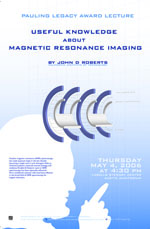Abstract

“Useful Knowledge about Magnetic Resonance Imaging” Watch Video
Roberts' lecture details the mechanisms by which nuclear magnetic resonance (NMR) spectroscopy works as well as the ways in which magnetic resonance imaging (MRI) is derived from NMR. Roberts also discusses the analysis of MRI and the technique's significance in the study of anatomy and medicine. Further advancements in the field, including Echo-Planar Imaging, are also mentioned.
As Roberts notes, by applying different gradients of magnetic fields the positions of atomic nuclei can be determined. From here, slices of a three-dimensional image, such as a human body, can be mapped out. The contrast in MRIs is produced by the different concentrations of water in different parts of the body like bone, muscle, and blood. Examination of these contrasts can then be used to diagnose patients with diseases like cancer, without having to perform investigative surgery.
Related Names: Linus Pauling


